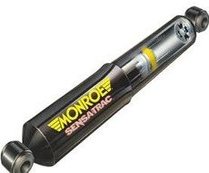Automotive shock absorbers

Automotive shock absorbers help provide the comfortable ride that everybody is looking for. The more weight the automobile caries the more important having the right shock installed becomes. I have found this to be one of the most misunderstood car suspension parts.
In some cases drivers associate poor road performance with bad shocks. Auto repair centers are also motivated to sell replacement shocks and can use this to up-sell possibly unnecessary repairs. To make matters worse when customers and car repair shops negotiate for the replacement the vehicle owner will be offered several choices. The most common would be standard or gas charged.
 |
The auto repair shop may make unsubstantiated claims that the more expensive gas charge shock will provide better ride and longer lasting service. This will depend on driving conditions.
In my personal opinion, a regular passenger car will do just fine with your standard hydraulic automotive shock absorbers. Also in my opinion gas charge shocks and super expensive brands like Bilstein are fantastic for road racers and sports car enthusiasts but may be overkill for commuters that drive mostly on smooth highways.
Car shocks
automotive shock absorbers are designed to limit the up-and-down movement of the vehicles sprung weight. When these parts are removed the vehicle will bounce wildly for a long period of time.In fact, in other countries this part is known as a hydraulic dampening device and called dampers. What makes this hydraulic oil filled tube so effective is the faster it moves the more resistance it has to that movement. There are very few parts that make up a standard shock. The outer tube holds a small amount of hydraulic fluid.
The top part of the shock is attached to a piston rod that fits down inside the tube. At the end of the rod is a piston skirt that has small clearances to the tube wall. This allows fluid to be squished up and down inside the tube and pass between 2 chambers.
Modern standard shock absorbers can last up to 100,000 miles, depending on driving conditions. For me the first sign of a failed shock or strut is tire wear.
This is from the tire smacking against the road wildly. When this happens you get choppy tread wear that in extreme cases can make your tire look like a stop sign. Also described as high and low spots. When a standard hydraulic shock fails you can usually see a fluid leak from the piston rod seal.
When this occurs hydraulic oil can be clearly visible on the outer body of the shock. Another issue can be if the tube is damaged from a collision or external road debris. If you see this then I would not hesitate in replacing the damaged parts.
Gas charged shock absorbers

Why the gas charged shock was invented. On rough roads the rapid movement of fluid in a standard hydraulic shock can cause a foaming condition. This can reduce the efficiency of the dampening.
In a gas charged shock there is no fluid to foam up. These gas charge shock absorbers are more expensive and also harder to diagnose when they do fail. The gas inside the shock can have pressures over 350 psi. This makes the piston rod seal a very important part of this suspension component.
The standard procedure for testing shocks would be the bumper bounce test. This is when you push down and compress the suspension and then release it to monitor the rebound. In general as a rule of thumb, the automobile should rise one time above the starting line and one time below before it settles.
This will only help you diagnose pairs of worn parts. What if you suspect that only one has failed. If I suspect 1 failed gas charged dampener in my opinion the easiest way to confirm diagnosis is to actually remove the part and hand test it.
Both hydraulic and gas charged automotive shock absorbers should provide extreme resistance in both up-and-down movement. Also the faster the resistance is applied, the harder it should be to compress. Keep in mind that when you replace automotive standard shock absorbers that these are designed for individual and specific vehicles. Vehicle manufacturers calculate the ratio of control (stiffness) required on their specific model.
Give this automotive shock absorbers page a share or bookmark

No comments:
Post a Comment